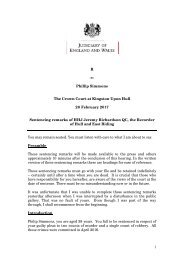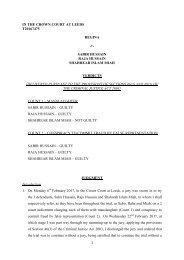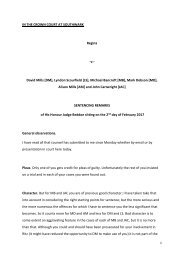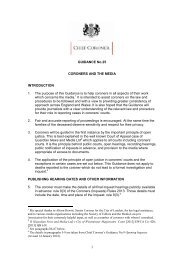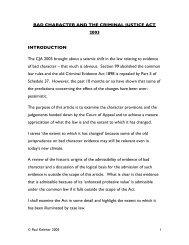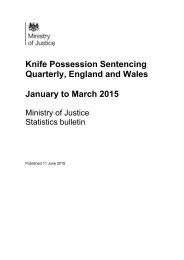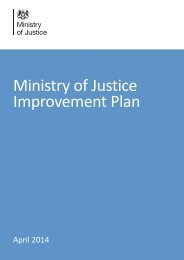HMP Doncaster
Doncaster-web-2015
Doncaster-web-2015
You also want an ePaper? Increase the reach of your titles
YUMPU automatically turns print PDFs into web optimized ePapers that Google loves.
Section 2. Respect<br />
Recommendation<br />
2.18 The diversity and equality action plan should be implemented, diversity should<br />
be promoted, and disparities emerging from equality monitoring data<br />
systematically addressed.<br />
Protected characteristics<br />
2.19 Eighteen per cent of the population were from a black or minority ethnic background. Their<br />
responses to our survey questions were largely comparable to white prisoners, although<br />
there were significant exceptions; for example, more said they were victimised by staff (40%<br />
against 28%). Our survey indicated that there were about 40 Gypsy and Traveller prisoners<br />
but the prison had only identified 16. These prisoners did not meet as a group or receive<br />
specific support.<br />
2.20 Support for foreign nationals prisoners (6% of the population) was good and better than we<br />
usually see. The equality and diversity coordinator assessed the individual needs of all foreign<br />
national new arrivals. The prison had surveyed foreign nationals’ needs and created an action<br />
plan to meet them, some of which had been implemented. Foreign nationals could send a<br />
free weekly email letter and those without visitors received an additional £10 telephone<br />
credit a month. Immigration enforcement officers attended the prison fortnightly to<br />
interview foreign nationals of interest to them. The equality and diversity coordinator<br />
referred foreign nationals to a local firm of solicitors, distributed Bail for Immigration<br />
Detainee factsheets in English and other languages, and facilitated bail applications. At the<br />
time of our inspection, there were nine immigration detainees held after the end of their<br />
custodial sentence, and it was not clear why some could not be moved to an immigration<br />
removal centre. Immigration enforcement officers informed some detainees of their further<br />
detention only on the day their sentence ended. The foreign national policy and information<br />
booklet were out of date.<br />
2.21 The prison had identified 145 prisoners with disabilities, yet our survey suggested about 300<br />
such prisoners. The needs of some but not all disabled prisoners were met. In our survey,<br />
disabled prisoner were more negative about safety issues than those without a disability. The<br />
prison was developing a social care unit in the annexe, which held 23 prisoners in need of<br />
care because of their disability or age, but it was sometimes only staffed by one officer and<br />
could not accommodate all disabled prisoners. Some were held in cells without adaptations<br />
on the regular residential units. Disabled prisoners had emergency evacuation plans and basic<br />
care plans. Social services recommendations were not always implemented. For example,<br />
one prisoner had not received a hospital bed that he required. A wheelchair user told us that<br />
he had not showered in over two years because there had been no reasonable adjustments<br />
to enable him to access a shower. Prisoners were employed as helpers to assist disabled<br />
prisoners with their day-to-day living, and clearly understood the boundaries and limits of<br />
their role.<br />
2.22 Young adults comprised 15% of the population and were mostly held on two house blocks.<br />
In our survey, they were more negative than prisoners over 21 in their responses to more<br />
than half the questions. For example, only 43%, compared with 81%, said that staff treated<br />
them with respect, and no young adults, against 24% of those over 21, said that staff normally<br />
spoke to them during association. The prison’s own data showed that young adults were<br />
over-represented in proven adjudications, good order or discipline, the basic level of the IEP<br />
scheme, use of force and full control and restraint techniques. Despite this, the prison had<br />
no strategy to meet their needs.<br />
34 <strong>HMP</strong> <strong>Doncaster</strong>



